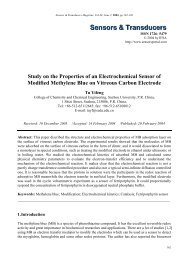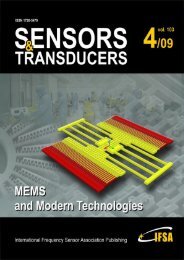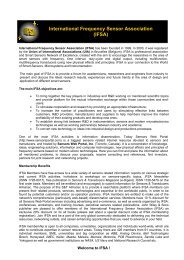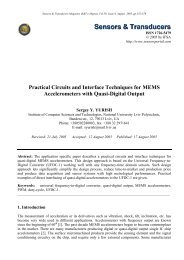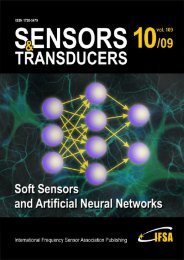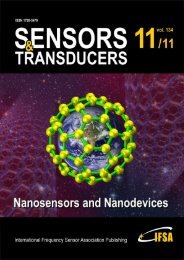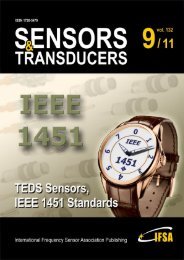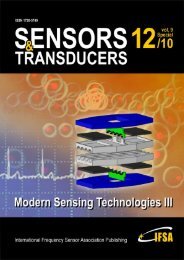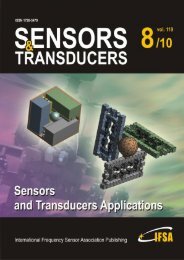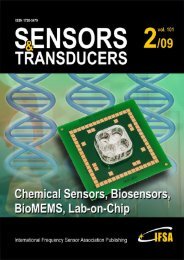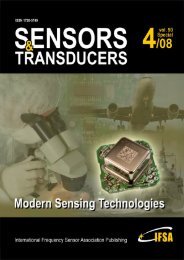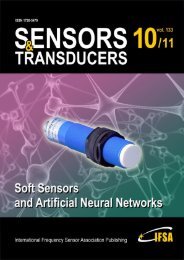Porous Silicon Hydrogen Sensor at Room Temperature
Porous Silicon Hydrogen Sensor at Room Temperature
Porous Silicon Hydrogen Sensor at Room Temperature
You also want an ePaper? Increase the reach of your titles
YUMPU automatically turns print PDFs into web optimized ePapers that Google loves.
<strong>Sensor</strong>s & TransducersVolume 103, Issue 4April 2009www.sensorsportal.com ISSN 1726-5479Editor-in-Chief: professor Sergey Y. Yurish, phone: +34 696067716, fax: +34 93 4011989, e-mail: editor@sensorsportal.comEditors for Western EuropeMeijer, Gerard C.M., Delft University of Technology, The NetherlandsFerrari, Vittorio, Universitá di Brescia, ItalyEditor South AmericaCosta-Felix, Rodrigo, Inmetro, BrazilEditor for Eastern EuropeSachenko, An<strong>at</strong>oly, Ternopil St<strong>at</strong>e Economic University, UkraineAbdul Rahim, Ruzairi, Universiti Teknologi, MalaysiaAhmad, Mohd Noor, Nothern University of Engineering, MalaysiaAnnamalai, Karthigeyan, N<strong>at</strong>ional Institute of Advanced Industrial Scienceand Technology, JapanArcega, Francisco, University of Zaragoza, SpainArguel, Philippe, CNRS, FranceAhn, Jae-Pyoung, Korea Institute of Science and Technology, KoreaArndt, Michael, Robert Bosch GmbH, GermanyAscoli, Giorgio, George Mason University, USAAtalay, Selcuk, Inonu University, TurkeyAtghiaee, Ahmad, University of Tehran, IranAugutis, Vygantas, Kaunas University of Technology, LithuaniaAvachit, P<strong>at</strong>il Lalchand, North Maharashtra University, IndiaAyesh, Aladdin, De Montfort University, UKBahreyni, Behraad, University of Manitoba, CanadaBaoxian, Ye, Zhengzhou University, ChinaBarford, Lee, Agilent Labor<strong>at</strong>ories, USABarlingay, Ravindra, RF Arrays Systems, IndiaBasu, Sukumar, Jadavpur University, IndiaBeck, Stephen, University of Sheffield, UKBen Bouzid, Sihem, Institut N<strong>at</strong>ional de Recherche Scientifique, TunisiaBenachaiba, Chellali, Universitaire de Bechar, AlgeriaBinnie, T. David, Napier University, UKBischoff, Gerlinde, Inst. Analytical Chemistry, GermanyBodas, Dhananjay, IMTEK, GermanyBorges Carval, Nuno, Universidade de Aveiro, PortugalBousbia-Salah, Mounir, University of Annaba, AlgeriaBouvet, Marcel, CNRS – UPMC, FranceBrudzewski, Kazimierz, Warsaw University of Technology, PolandCai, Chenxin, Nanjing Normal University, ChinaCai, Qingyun, Hunan University, ChinaCampanella, Luigi, University La Sapienza, ItalyCarvalho, Vitor, Minho University, PortugalCecelja, Franjo, Brunel University, London, UKCerda Belmonte, Judith, Imperial College London, UKChakrabarty, Chandan Kumar, Universiti Tenaga Nasional, MalaysiaChakravorty, Dipankar, Associ<strong>at</strong>ion for the Cultiv<strong>at</strong>ion of Science, IndiaChanghai, Ru, Harbin Engineering University, ChinaChaudhari, Gajanan, Shri Shivaji Science College, IndiaChen, Jiming, Zhejiang University, ChinaChen, Rongshun, N<strong>at</strong>ional Tsing Hua University, TaiwanCheng, Kuo-Sheng, N<strong>at</strong>ional Cheng Kung University, TaiwanChiang, Jeffrey (Cheng-Ta), Industrial Technol. Research Institute, TaiwanChiriac, Horia, N<strong>at</strong>ional Institute of Research and Development, RomaniaChowdhuri, Arijit, University of Delhi, IndiaChung, Wen-Yaw, Chung Yuan Christian University, TaiwanCorres, Jesus, Universidad Publica de Navarra, SpainCortes, Camilo A., Universidad Nacional de Colombia, ColombiaCourtois, Christian, Universite de Valenciennes, FranceCusano, Andrea, University of Sannio, ItalyD'Amico, Arnaldo, Università di Tor Verg<strong>at</strong>a, ItalyDe Stefano, Luca, Institute for Microelectronics and Microsystem, ItalyDeshmukh, Kiran, Shri Shivaji Mahavidyalaya, Barshi, IndiaDickert, Franz L., Vienna University, AustriaDieguez, Angel, University of Barcelona, SpainDimitropoulos, Panos, University of Thessaly, GreeceDing, Jianning, Jiangsu Polytechnic University, ChinaDjordjevich, Alexandar, City University of Hong Kong, Hong KongEditorial Advisory BoardEditors for North AmericaD<strong>at</strong>skos, Panos G., Oak Ridge N<strong>at</strong>ional Labor<strong>at</strong>ory, USAFabien, J. Josse, Marquette University, USAK<strong>at</strong>z, Evgeny, Clarkson University, USAEditor for AsiaOhyama, Shinji, Tokyo Institute of Technology, JapanEditor for Asia-PacificMukhopadhyay, Subhas, Massey University, New ZealandDon<strong>at</strong>o, Nicola, University of Messina, ItalyDon<strong>at</strong>o, P<strong>at</strong>ricio, Universidad de Mar del Pl<strong>at</strong>a, ArgentinaDong, Feng, Tianjin University, ChinaDrljaca, Predrag, Instersema <strong>Sensor</strong>ic SA, SwitzerlandDubey, Venketesh, Bournemouth University, UKEnderle, Stefan, University of Ulm and KTB Mech<strong>at</strong>ronics GmbH,GermanyErdem, Gursan K. Arzum, Ege University, TurkeyErkmen, Aydan M., Middle East Technical University, TurkeyEstelle, P<strong>at</strong>rice, Insa Rennes, FranceEstrada, Horacio, University of North Carolina, USAFaiz, Adil, INSA Lyon, FranceFericean, Sorin, Balluff GmbH, GermanyFernandes, Joana M., University of Porto, PortugalFrancioso, Luca, CNR-IMM Institute for Microelectronics andMicrosystems, ItalyFrancis, Laurent, University C<strong>at</strong>holique de Louvain, BelgiumFu, Weiling, South-Western Hospital, Chongqing, ChinaGaura, Elena, Coventry University, UKGeng, Yanfeng, China University of Petroleum, ChinaGole, James, Georgia Institute of Technology, USAGong, Hao, N<strong>at</strong>ional University of Singapore, SingaporeGonzalez de la Rosa, Juan Jose, University of Cadiz, SpainGranel, Annette, Goteborg University, SwedenGraff, Mason, The University of Texas <strong>at</strong> Arlington, USAGuan, Shan, Eastman Kodak, USAGuillet, Bruno, University of Caen, FranceGuo, Zhen, New Jersey Institute of Technology, USAGupta, Narendra Kumar, Napier University, UKHadjiloucas, Sillas, The University of Reading, UKHashsham, Syed, Michigan St<strong>at</strong>e University, USAHasni, Abdelhafid, Bechar University, AlgeriaHernandez, Alvaro, University of Alcala, SpainHernandez, Wilmar, Universidad Politecnica de Madrid, SpainHomentcovschi, Dorel, SUNY Binghamton, USAHorstman, Tom, U.S. Autom<strong>at</strong>ion Group, LLC, USAHsiai, Tzung (John), University of Southern California, USAHuang, Jeng-Sheng, Chung Yuan Christian University, TaiwanHuang, Star, N<strong>at</strong>ional Tsing Hua University, TaiwanHuang, Wei, PSG Design Center, USAHui, David, University of New Orleans, USAJaffrezic-Renault, Nicole, Ecole Centrale de Lyon, FranceJaime Calvo-Galleg, Jaime, Universidad de Salamanca, SpainJames, Daniel, Griffith University, AustraliaJanting, Jakob, DELTA Danish Electronics, DenmarkJiang, Liudi, University of Southampton, UKJiang, Wei, University of Virginia, USAJiao, Zheng, Shanghai University, ChinaJohn, Joachim, IMEC, BelgiumKalach, Andrew, Voronezh Institute of Ministry of Interior, RussiaKang, Moonho, Sunmoon University, Korea SouthKaniusas, Eugenijus, Vienna University of Technology, AustriaK<strong>at</strong>ake, Anup, Texas A&M University, USAKausel, Wilfried, University of Music, Vienna, AustriaKavasoglu, Nese, Mugla University, TurkeyKe, C<strong>at</strong>hy, Tyndall N<strong>at</strong>ional Institute, IrelandKhan, Asif, Aligarh Muslim University, Aligarh, IndiaKim, Min Young, Kyungpook N<strong>at</strong>ional University, Korea South
<strong>Sensor</strong>s & Transducers JournalContentsVolume 103Issue 4April 2009www.sensorsportal.com ISSN 1726-5479Research ArticlesFrontiers of Nanosensor TechnologyVinod Kumar Khanna ......................................................................................................................... 1Dual Comb Unit High-g Accelerometer Based on CMOS-MEMS TechnologyMehrdad Mottaghi, Farzan Ghalichi, Habib B. Ghavifekr................................................................... 17Modeling of Micromachined Thermopiles Powered from the Human Body for EnergyHarvesting in Wearable DevicesVladimir Leonov, Ziyang Wang, Paolo Fiorini and Chris Van Hoof .................................................... 29Design and Development of Polysilicon-based Microhotpl<strong>at</strong>e for Gas Sensing Applic<strong>at</strong>ionMahanth Prasad, V. K. Khanna and Ram Gopal................................................................................ 44Design of a Capacitive SOI Micromachined AccelerometerWenjing Zhao, Limei Xu. .................................................................................................................... 52Characteristic Fe<strong>at</strong>ures of RF MEMS Switches and its Various Applic<strong>at</strong>ionsB. Mishra, Z. C. Alex........................................................................................................................... 65Study on the Effects of Added Mass on Mechanical Behavior of a MicrobeamMohammad F<strong>at</strong>halilou, Ghader Rezazadeh, Yashar Alizadeh, Soheil Talebian ............................... 73Titanium Hydride Form<strong>at</strong>ion in Current-Biased Titanium Microbolometer andNanobolometer DevicesS. F. Gilmartin, K. Arshak, D. Collins, B. Lane, D. Bain, S. B. Newcomb, B. McCarthy, A. Arshak. . 83Squeeze-Film Damping Effect on Dynamic Pull-in Voltage of an Electrost<strong>at</strong>ically-Actu<strong>at</strong>edMicrobeamHadi Yagubizade, Mohammad F<strong>at</strong>halilou, Ghader Rezazadeh, Soheil Talebian .............................. 96<strong>Porous</strong> <strong>Silicon</strong> <strong>Hydrogen</strong> <strong>Sensor</strong> <strong>at</strong> <strong>Room</strong> Temper<strong>at</strong>ure: the Effect of Surface Modific<strong>at</strong>ionand Noble Metal ContactsJayita Kanungo, Hiranmay Saha, Sukumar Basu .............................................................................. 102Design and Analyses of Electromagnetic Microgener<strong>at</strong>orNibras Awaja, Dinesh Sood, Thurai Vinay. ........................................................................................ 109Dynamic Pull-in Phenomenon in the Fully Clamped Electrost<strong>at</strong>ically Actu<strong>at</strong>ed RectangularMicropl<strong>at</strong>es Considering Damping EffectsGhader Rezazadeh, Soheil Talebian, Mohammad F<strong>at</strong>halilou............................................................ 122Finite Element Analysis of St<strong>at</strong>ic and Dynamic Pull-In Instability of a Fixed-Fixed MicroBeam Considering Damping EffectsMohammad Reza Ghazavi, Ghader Rezazadeh, Saber Azizi ........................................................... 132
Effect of Polyimide Vari<strong>at</strong>ion and its Curing Temper<strong>at</strong>ure on CMOS Based CapacitiveHumidity <strong>Sensor</strong> and Characteriz<strong>at</strong>ion of Integr<strong>at</strong>ed He<strong>at</strong>erB. N. Baliga, D. N. Tiwari,Kamaljeet Singh, Sanjay Verma,K. Nagachenchaiah ............................... 144Sputtered <strong>Silicon</strong> as a Potential Masking M<strong>at</strong>erial for Glass Micromachining – A FeasibilityStudyAbhay B. Joshi, Dhananjay Bodas, S. A. Gangal............................................................................... 155Thermo-Mechanical Behavior of a Bilayer Microbeam Subjected to Nonlinear Electrost<strong>at</strong>icPressureMaliheh Pashapour, Seyed-Mehdi Pesteii, Ghader Rezazadeh, Shahriyar Kouravand.................... 161<strong>Hydrogen</strong> and Methane Response of Pd G<strong>at</strong>e MOS <strong>Sensor</strong>Preeti Pandey, J. K. Srivastava, V. N. Mishra and R. Dwivedi........................................................... 171Authors are encouraged to submit article in MS Word (doc) and Acrob<strong>at</strong> (pdf) form<strong>at</strong>s by e-mail: editor@sensorsportal.comPlease visit journal’s webpage with prepar<strong>at</strong>ion instructions: http://www.sensorsportal.com/HTML/DIGEST/Submition.htmIntern<strong>at</strong>ional Frequency <strong>Sensor</strong> Associ<strong>at</strong>ion (IFSA).
<strong>Sensor</strong>s & Transducers Journal, Vol. 103, Issue 4, April 2009, pp. 102-108<strong>Sensor</strong>s & TransducersISSN 1726-5479© 2009 by IFSAhttp://www.sensorsportal.com<strong>Porous</strong> <strong>Silicon</strong> <strong>Hydrogen</strong> <strong>Sensor</strong> <strong>at</strong> <strong>Room</strong> Temper<strong>at</strong>ure:The Effect of Surface Modific<strong>at</strong>ion and Noble Metal ContactsJayita KANUNGO, Hiranmay SAHA, * Sukumar BASUIC Design & Fabric<strong>at</strong>ion Centre, Dept. of Electronics & Telecommunic<strong>at</strong>ion Engineering,Jadavpur University, Kolk<strong>at</strong>a-700032, India* Tel: +913324146217, fax: +913324146217E-mail: sukumar_basu@yahoo.co.ukReceived: 14 January 2008 /Accepted: 20 April 2009 /Published: 27 April 2009Abstract: <strong>Porous</strong> silicon (PS) was fabric<strong>at</strong>ed by anodiz<strong>at</strong>ion of p-type crystalline silicon of resistivity2-5 Ω cm. After form<strong>at</strong>ion, the PS surface was modified by the solution containing noble metal likePd. Pd-Ag c<strong>at</strong>alytic contact electrodes were deposited on porous silicon and on p-<strong>Silicon</strong> to fabric<strong>at</strong>ePd-Ag/PS/p-Si/Pd-Ag sensor structure to carry out the hydrogen sensing experiments. The <strong>Sensor</strong> wasexposed to 1% hydrogen in nitrogen as carrier gas <strong>at</strong> room temper<strong>at</strong>ure (27 0 C). Pd modified sensorshowed minimum fluctu<strong>at</strong>ions and consistent performance with 86% response, response time andrecovery time of 24 sec and 264 sec respectively. The stability experiments were studied for bothunmodified and Pd modified sensor structures for a period of about 24 hours and the modified sensorsshowed excellent durability with no drift in response behavior. Copyright © 2009 IFSA.Keywords: <strong>Porous</strong> silicon, Pd surface modific<strong>at</strong>ion, Heterojunction, <strong>Hydrogen</strong> sensor, Stability1. Introduction<strong>Hydrogen</strong> is gaining interest as the promising source of cost effective and clean altern<strong>at</strong>ive fuel in nearfuture. <strong>Hydrogen</strong> is also used in the production of industrial chemicals and food products. But safety isan important issue while using hydrogen - an odorless and colourless gas with an explosion limit4.65% to 93.9% in air. Commercially available sensors can detect the presence of hydrogen but havelimit<strong>at</strong>ions rel<strong>at</strong>ed to cost, speed of oper<strong>at</strong>ion, susceptibility to interference from other gases andtemper<strong>at</strong>ure range etc. Numerous approaches are being pursued to develop the hydrogen sensors,including silicon and oxide based thin film devices with an aim to overcome these problems [1-4].102
<strong>Sensor</strong>s & Transducers Journal, Vol. 103, Issue 4, April 2009, pp. 102-108<strong>Porous</strong> silicon (PS), obtained conventionally by anodis<strong>at</strong>ion of crystalline p-type silicon, is a potentialpl<strong>at</strong>form for high efficiency gas sensors mainly due to its very large surface to volume r<strong>at</strong>io, whichenhances adsorption of the sensing gas, a primary step for gas sensor [5-6]. Also the high chemicalreactivity of PS with the environment and the possibility of porosity control by the vari<strong>at</strong>ion of theform<strong>at</strong>ion parameters further cre<strong>at</strong>e an interest in sensing applic<strong>at</strong>ions. Additionally, it is easy tofabric<strong>at</strong>e sensors using PS with comp<strong>at</strong>ibility to silicon IC technology. Despite all the aboveadvantages, problems such as stability, reversibility, and selectivity requires investig<strong>at</strong>ion in details forits commercial use. Though some of these problems have been addressed before [7, 8], thestabiliz<strong>at</strong>ion of PS and minimiz<strong>at</strong>ion of electrical drift in the actual device performance are still twomajor barriers against the fabric<strong>at</strong>ion of PS based devices for field applic<strong>at</strong>ions. Several tre<strong>at</strong>ments tostabilize the PS structure have been reported e.g. controlled thermal oxid<strong>at</strong>ion, nitrid<strong>at</strong>ion,halogen<strong>at</strong>ion and polymeriz<strong>at</strong>ion etc. Surface passiv<strong>at</strong>ion by noble metals may also be very useful, asreported in the liter<strong>at</strong>ure [9, 10]. For gas sensor applic<strong>at</strong>ions, the aim of Pd modific<strong>at</strong>ion is two-fold.First of all, to passiv<strong>at</strong>e the surface by noble metals to get long term stability and then to improve theelectrical response in presence of gases due to its c<strong>at</strong>alytic effect, while maintaining the large specificsurface area of PS.Palladium doped PS based hydrogen sensor was first reported by Polishchuk and co-workers [11]using contact potential difference vari<strong>at</strong>ions (CPD). K. Luongo el al [12] reported a room temper<strong>at</strong>ureimpedance H 2 sensor using nano structured Pd doped layer on the nano porous silicon surface.P. K. Sekhar and co workers tried to find out the influence of anodis<strong>at</strong>ion current density and etchingtime during PS form<strong>at</strong>ion on the response time and stability of Pd doped sensors using the sameelectrode configur<strong>at</strong>ion as reported earlier. [13]. In 2006 Rahimi et al. worked on the importantparameters for Pd growth on PS by electroless pl<strong>at</strong>ing and briefly observed the response to hydrogenfor both l<strong>at</strong>eral and sandwich structures using comb like gold electrical contacts [14].In this paper, we specifically focus on the fabric<strong>at</strong>ion of a stabilized porous silicon based hydrogensensor after modifying the PS surface using noble metal ion like Pd by a simple, reliable and a low costchemical method. The response behavior, time of response and recovery, reproducibility and long termstability are reported here.2. ExperimentalThe nanocrystalline PS samples were prepared by the electrochemical etching of p-type Si wafers of(100) orient<strong>at</strong>ion and 2-5 Ω cm resistivity using a mixture of HF and ethanol (7:3) as electrolyte. Theporosity and thickness of the PS layers (55% and 5 µm) were measured gravimetrically using aprecision semi microbalance type, 290-9842/K of PAG OERLIKONAG CH-DIETKON (Switzerland)[15]. After form<strong>at</strong>ion, PS samples were dipped into 10% HF solution for 10 sec to remove the n<strong>at</strong>iveoxide layer and were immedi<strong>at</strong>ely dipped into the weak acidic solutions (0.01 M) of PdCl 2 for 5 sec.Subsequently the samples were rinsed gently by DI w<strong>at</strong>er and dried in air followed by annealing in air<strong>at</strong> 110 0 C for 10 min inside an electric oven. Different set of experiments was carried out to optimizemodific<strong>at</strong>ion time and solution strength. Pd-Ag (26%) c<strong>at</strong>alytic metal electrodes (Ag was alloyed to Pdto prevent deterior<strong>at</strong>ion of Pd surface due to hydride form<strong>at</strong>ion) of the dimension 2 mm x 2 mm andthickness 0.2µm were deposited on the unmodified and modified porous silicon surfaces and on thebottom p-Si surfaces of the samples by e-beam evapor<strong>at</strong>ion using an Al metal mask. Thin copper wireswere connected to these metal electrodes using silver paste for electrical measurements. The sensorstructure was effectively a back-to-back Schottky configur<strong>at</strong>ion.For the sensor study the samples were placed inside a closed corning glass tube with inlet and outletprovisions for gases. The tube was placed coaxially inside a resistively he<strong>at</strong>ed furnace with a 4 cmconstant temper<strong>at</strong>ure zone. High purity hydrogen and nitrogen were used for the experiments. To103
<strong>Sensor</strong>s & Transducers Journal, Vol. 103, Issue 4, April 2009, pp. 102-108measure and to control the flow r<strong>at</strong>es of the gases precisely throughout the experiments, mass flowmeters and controllers (Digiflow, USA) were used. The current-voltage characteristics were studied bythe Keithley Pico ammeter-voltage source (model 6487).3. ResultsThe schem<strong>at</strong>ic of the gas sensor device with Pd-Ag/PS/p-Si/Pd-Ag structure is given in Fig. 1. Thesensors were studied with 1% hydrogen in nitrogen as carrier gas. The response is defined here as thechange in current in presence of hydrogen to the current in air <strong>at</strong> constant voltage in the forward bias⎛ Ia− Ig ⎞mode and is expressed as S=⎜I⎟ where I a is the current in air and I g is the current in presence⎝ a ⎠Vof gas. The detail sensor studies were carried out <strong>at</strong> room temper<strong>at</strong>ure (27 0 C) as the sensor getsdamaged <strong>at</strong> higher temper<strong>at</strong>ures mainly due to the surface of PS.Fig. 1. Schem<strong>at</strong>ic of sensor geometry.Fig. 2. shows the response-voltage characteristics of unmodified and modified PS sensors havingPd-Ag/PS/p-Si/Pd-Ag structures <strong>at</strong> room temper<strong>at</strong>ure in 1 % hydrogen gas mixed with nitrogen carriergas. The maximum response for unmodified PS is 62 % <strong>at</strong> 0.9 V, whereas, in case of modified PS themaximum response obtained is 86 % <strong>at</strong> a lower bias of 0.5 V.1.00.8Pd-Ag/PS/p-Si/Pd-AgTemp 27 0 structureC; 1% H 2Response0.60.40.20.0Unmodified PSPd modified PS0.0 0.3 0.6 0.9 1.2 1.5Voltage (V)Fig. 2. <strong>Room</strong> temper<strong>at</strong>ure response-voltage characteristics of unmodified and Pd-modified PS sensors havingPd-Ag/PS/p-Si/Pd-Ag structures in 1 % hydrogen gas in nitrogen.104
<strong>Sensor</strong>s & Transducers Journal, Vol. 103, Issue 4, April 2009, pp. 102-108Fig. 3 shows the repe<strong>at</strong>ed cycle of unmodified and surface modified porous silicon hydrogen sensorsoper<strong>at</strong>ing <strong>at</strong> room temper<strong>at</strong>ure corresponding to their optimum biasing voltages. It is clear from thefigure th<strong>at</strong> the sensor response is more stable for Pd modified samples with a little drift in the base linevalue and with response and recovery time of 24 sec and 264 sec respectively. Table.1 presents thevalues of response, response time and recovery time of the unmodified and modified PS sensors. Fig. 4demonstr<strong>at</strong>es the transient response <strong>at</strong> different concentr<strong>at</strong>ions of hydrogen for unmodified andPd modified PS sensors with Pd-Ag/PS/p-Si/Pd-Ag structure.Response1.00.80.60.40.2Pd-Ag/PS/p-Si/Pd-Ag structure1% H 2; Temp 27 0 CUnmodified PSPd modified PS.0.00 2000 4000 6000 8000 10000 12000Time (sec)Fig. 3. Repe<strong>at</strong>ed cycle of transient response graph for unmodified and modified PS sensors havingPd-Ag/PS/p-Si/Pd-Ag structures.Response0.80.60.40.20.00.01%0.05%0.1%0.5%1%Pd-Ag/PS/p-Si/Pd-Ag structureTemp 27 0 C0 5000 10000 15000 20000Time (sec)Unmodified PSPd modified PSFig. 4. Transient response <strong>at</strong> different concentr<strong>at</strong>ions of hydrogen for unmodified and Pd modified PS sensorswith Pd-Ag/PS/p-Si/Pd-Ag structure.105
<strong>Sensor</strong>s & Transducers Journal, Vol. 103, Issue 4, April 2009, pp. 102-108Table 1. Sensing parameters for both unmodified and modified PS sensors having c<strong>at</strong>alytic (Pd-Ag) contactelectrodes.StructureTemper<strong>at</strong>ure( 0 C)BiasingVoltage(V)Response(%)ResponseTime(Sec)RecoveryTime(Sec)Pd-Ag/PS/p-Si/Pd-Ag 27 0.9 62 131 1237Pd-Ag/mod-PS/p-Si/Pd-Ag 27 0.5 86 24 264The stability of both unmodified and modified PS sensors was tested with 1% hydrogen in nitrogen <strong>at</strong>27 0 C for 24 hours with dur<strong>at</strong>ion of 8 hr per day <strong>at</strong> the biasing voltage corresponding to their optimumresponse and is shown in Fig. 5. It is clear from the figure th<strong>at</strong> palladium-modified sensor shows thebest consistency in stability.Current (nA)1412108642Pd-Ag/PS/p-Si/Pd-Ag structure1% hydrogen;Temp 27 0 CPd modified PS [ 0.5V]Unmodified PS [ 0.9V][c]00 200 400 600 800 1000 1200 1400Time ( min)Fig. 5. Stability study for unmodified & Pd modified PS sensors with Pd-Ag/PS/p-Si/Pd-Ag structure.4. DiscussionThe Pd-Ag/PS/p-Si/Pd-Ag structure produces back-to-back Schottky barriers due to Pd-Ag/PS andPd-Ag/p-Si junctions, with an additional PS/p-Si heterojunction. It is known th<strong>at</strong> the porous siliconlayer contains a large density of surface and interface st<strong>at</strong>es leading to Fermi-level pinning <strong>at</strong> themetal/PS interface. This may affect the electrical response of metal/PS junctions. Our results showedth<strong>at</strong> the response and stability of a PS sensor improves much more when its surface is modified withnoble metal. Dispersed noble metal islands over the PS surface react with some of the danglingelectrons and passiv<strong>at</strong>e them. Oxygen molecules weekly bonded with the c<strong>at</strong>alytic metal <strong>at</strong>omsdissoci<strong>at</strong>e yielding oxygen <strong>at</strong>oms. These oxygen <strong>at</strong>oms then undergo a spillover process and react withthe remaining dangling electrons of PS surface and passiv<strong>at</strong>e the defect st<strong>at</strong>es to a large extent (whichis also supported by our XPS results) and stabilize the m<strong>at</strong>erial. During hydrogen sensing hydrogenmolecule decomposes to hydrogen <strong>at</strong>oms on the c<strong>at</strong>alytic metal surface and diffuse through the c<strong>at</strong>alystand reach the noble metal–porous silicon interface where a dipole layer forms [14, 16, 17] and reducesthe work function of the metal. As a result the barrier height of the junction increases and the currentdecreases. Fig. 6a and 6b demonstr<strong>at</strong>e the energy band diagram (not in scale) of the Pd-Ag/PS junctioncoupled to the dipole structure due to hydrogen diffusion, showing an increase in PS band bending in106
<strong>Sensor</strong>s & Transducers Journal, Vol. 103, Issue 4, April 2009, pp. 102-108presence of hydrogen and thus decrease in current. Our results further showed th<strong>at</strong> Pd-Ag/p-Siinterface does not contribute to the enhanced gas sensing but cre<strong>at</strong>e a barrier against current flow. Inreference to our earlier work [18] on Pd modified PS based Pd-Ag/PS/p-Si/Al sensor structure, wherethe response was comparable (84%) but the response time was much faster (~ 8 sec) we can infer th<strong>at</strong>single Schottky junction is good enough for hydrogen sensing.Fig. 6. Band diagram (not in scale) of Pd-Ag/PS junction coupled with a dipole layer during hydrogen sensing.(a) Decrease in metal work function due to the form<strong>at</strong>ion of a dipole layer <strong>at</strong> the interface by the diffusedhydrogen (b) an increase in barrier height <strong>at</strong> the metal / PS junction.5. ConclusionOur experiments with Pd surface modified porous silicon on p-Si substr<strong>at</strong>e in the form of back to backSchottky barrier junctions using Pd-Ag c<strong>at</strong>alytic electrode contacts is useful as room temper<strong>at</strong>urehydrogen sensor with appreciably high response and considerably fast response time. The stability ofthe modified sensor structure is visibly much improved compared to the unmodified one. The sensingmechanism is clarified in respect of hydrogen dipole structure and reduction in metal work functionleading to an increase in barrier height of the junction in presence of hydrogen.Reference[1]. H. Nienhause, H. S. Berg, B. Gergen, A. Majumder, Selective H <strong>at</strong>om sensors using ultra thin Ag/SiSchottky diodes, Appl. Phys. Lett, 74, 1999, pp. 4046-4048.[2]. S. Basu, A. Dutta, <strong>Room</strong> temper<strong>at</strong>ure hydrogen sensors based on ZnO, M<strong>at</strong>erials Chemistry and Physics,47, 1997, pp. 93-96.[3]. S. K Hazra, S. Basu, High sensitivity and fast response hydrogen sensors based on electrochemicallyetched porous titania thin films, Sens. Actu<strong>at</strong>ors, B, Chem, 115, 2006, pp. 403-411.[4]. A. K<strong>at</strong>suki, K. Fukui, H 2 selective gas sensor based on SnO 2 , Sens. Actu<strong>at</strong>ors, B, Chem, 52, 1998,pp. 30-37.[5]. S. E. Lewis, J. R. DeBoer, J. L. Gole, P. J. Hesketh, Sensitive selective and analytical improvements to aporous silicon gas sensor, Sens. Actu<strong>at</strong>ors, B, Chem, 110, 2005, pp. 54-65.[6]. J. Mizsei, Gas sensor applic<strong>at</strong>ions of porous Si layers, Thin Solid Films, 515, 2007, pp. 8310-8315.[7]. S. N. Sharma, R. Banerjee , D. Das, S. Ch<strong>at</strong>topadhyay, A. K. Barua, Control of the crystallite size andpassiv<strong>at</strong>ion of defects in porous silicon by novel method, Appl. Surf. Sci., 182, 2001, pp. 333-337.[8]. Martin-Palma R. J., Perez-Rigueiro J., Guerrero-Lemus R., Moreno J. D., Martinez-Duart J., Ageing ofaluminium electrical contacts to porous silicon, J. Appl. Phys., 85, 1999, pp. 583-586.[9]. Roland Hérino, Nanocomposite m<strong>at</strong>erials from porous silicon, M<strong>at</strong>erial Science and Engineering, B,69- 70, 2000, pp. 70-76.[10]. M. Jeske, J. W. Schultze, M. Thönissen, H. Münder, Electrodeposition of metals into porous silicon, Thinsolid films, 255, 1995, pp. 63-66.107
<strong>Sensor</strong>s & Transducers Journal, Vol. 103, Issue 4, April 2009, pp. 102-108[11]. V. Polishchuk, E. Souteyrand, J. R. Martin, V. I. Strikha, V. A. Skryshevsky, A study of hydrogendetection with palladium modified porous silicon, Analytica Chimica Acta, 375, 1998, pp. 205-210.[12]. K. Luongo, A. Sine, S. Bhansali, Development of a highly sensitive porous Si based hydrogen sensor usingPd nano-structures, Sens. Actu<strong>at</strong>ors, B, Chem., 111–112, 2005, pp. 125–129.[13]. P. K. Sekhar, A. Sine, S. Bhansali, Effect of varying the nanostructured porous-Si process parameters onthe performance of Pd-doped hydrogen sensor, Sens. Actu<strong>at</strong>ors, B, Chem., 127, 2007, pp. 74–81.[14]. F. Rahimi, A. Irajizad, Effective factors on Pd growth on porous silicon by electroless-pl<strong>at</strong>ing: response tohydrogen, Sens. Actu<strong>at</strong>or, B, Chem., 115, 2006, pp. 164–169.[15]. J. Kanungo, C. Pramanik, S. Bandopadhyay, U. Gangopadhyay, L. Das, H. Saha, R. T. T. Gettens,Improved Contacts On <strong>Porous</strong> <strong>Silicon</strong> Layer By electroless Nickel Pl<strong>at</strong>ing and Copper Thickening,Semicond Sci and Technol., 21, 2006, pp. 964-970.[16]. M. Johansson, I. Lundstrorm, L. -G. Ekedahl, Bridging the pressure gap for palladium metal-insul<strong>at</strong>orsemiconductorhydrogen sensors in oxygen containing environments, J. Appl. Phys., 84, 1, 1998,pp. 44- 51.[17]. V. G. Litovchenko, T. I. Gorbanyuk, V. S. Solntsev, A. A. Evtukh, Mechanism of hydrogen, oxygen andhumidity sensing byCu/Pd-porous silicon–silicon structures, Applied Surface Science, 234, 2004,pp. 262–267.[18]. J. Kanungo, H. Saha, S. Basu, <strong>Room</strong> temper<strong>at</strong>ure Metal-Insul<strong>at</strong>or –Semiconductor (MIS) hydrogen sensorsbased on chemically surface modified porous silicon, communic<strong>at</strong>ed in <strong>Sensor</strong>s and Actu<strong>at</strong>ors, B.___________________2009 Copyright ©, Intern<strong>at</strong>ional Frequency <strong>Sensor</strong> Associ<strong>at</strong>ion (IFSA). All rights reserved.(http://www.sensorsportal.com)108
<strong>Sensor</strong>s & Transducers JournalGuide for ContributorsAims and Scope<strong>Sensor</strong>s & Transducers Journal (ISSN 1726-5479) provides an advanced forum for the science and technologyof physical, chemical sensors and biosensors. It publishes st<strong>at</strong>e-of-the-art reviews, regular research andapplic<strong>at</strong>ion specific papers, short notes, letters to Editor and sensors rel<strong>at</strong>ed books reviews as well asacademic, practical and commercial inform<strong>at</strong>ion of interest to its readership. Because it is an open access, peerreview intern<strong>at</strong>ional journal, papers rapidly published in <strong>Sensor</strong>s & Transducers Journal will receive a very highpublicity. The journal is published monthly as twelve issues per annual by Intern<strong>at</strong>ional Frequency Associ<strong>at</strong>ion(IFSA). In additional, some special sponsored and conference issues published annually. <strong>Sensor</strong>s &Transducers Journal is indexed and abstracted very quickly by Chemical Abstracts, IndexCopernicus JournalsMaster List, Open J-G<strong>at</strong>e, Google Scholar, etc.Topics CoveredContributions are invited on all aspects of research, development and applic<strong>at</strong>ion of the science and technologyof sensors, transducers and sensor instrument<strong>at</strong>ions. Topics include, but are not restricted to:• Physical, chemical and biosensors;• Digital, frequency, period, duty-cycle, time interval, PWM, pulse number output sensors and transducers;• Theory, principles, effects, design, standardiz<strong>at</strong>ion and modeling;• Smart sensors and systems;• <strong>Sensor</strong> instrument<strong>at</strong>ion;• Virtual instruments;• <strong>Sensor</strong>s interfaces, buses and networks;• Signal processing;• Frequency (period, duty-cycle)-to-digital converters, ADC;• Technologies and m<strong>at</strong>erials;• Nanosensors;• Microsystems;• Applic<strong>at</strong>ions.Submission of papersArticles should be written in English. Authors are invited to submit by e-mail editor@sensorsportal.com 8-14pages article (including abstract, illustr<strong>at</strong>ions (color or grayscale), photos and references) in both: MS Word(doc) and Acrob<strong>at</strong> (pdf) form<strong>at</strong>s. Detailed prepar<strong>at</strong>ion instructions, paper example and templ<strong>at</strong>e of manuscriptare available from the journal’s webpage: http://www.sensorsportal.com/HTML/DIGEST/Submition.htm Authorsmust follow the instructions strictly when submitting their manuscripts.Advertising Inform<strong>at</strong>ionAdvertising orders and enquires may be sent to sales@sensorsportal.com Please download also our media kit:http://www.sensorsportal.com/DOWNLOADS/Media_Kit_2009.pdf


